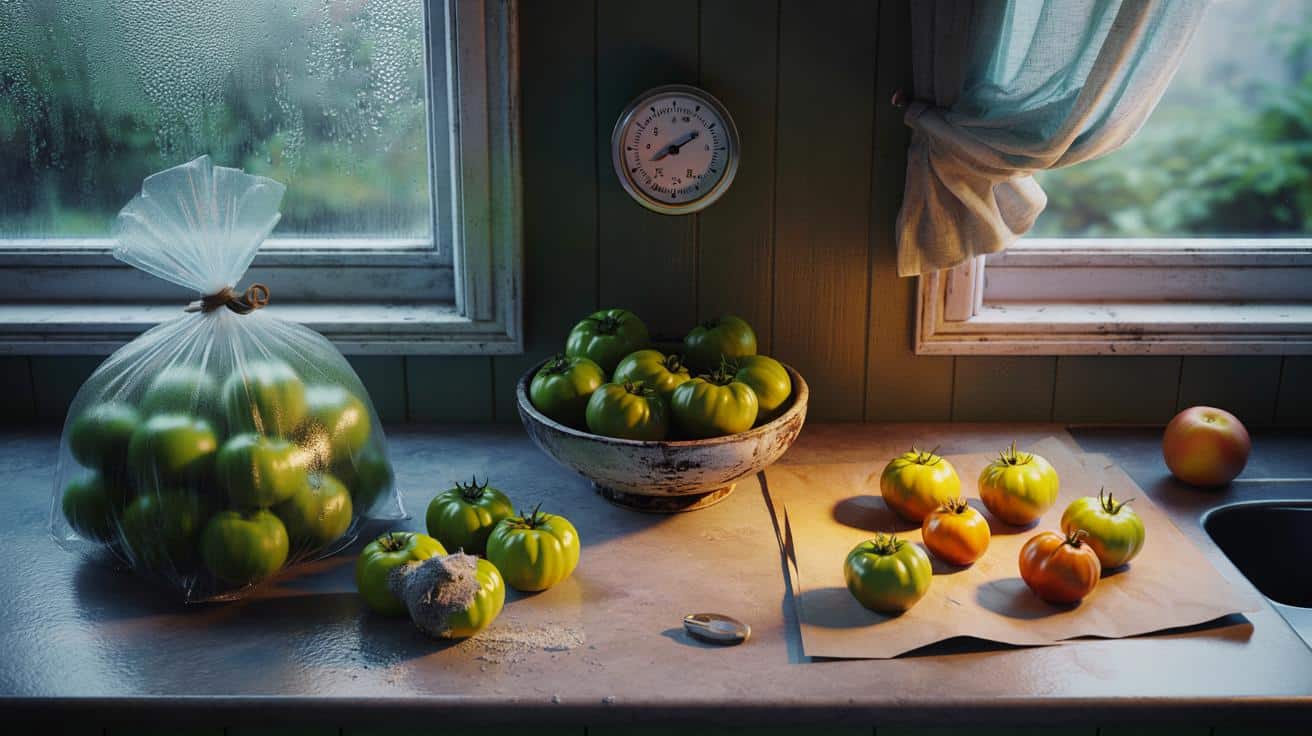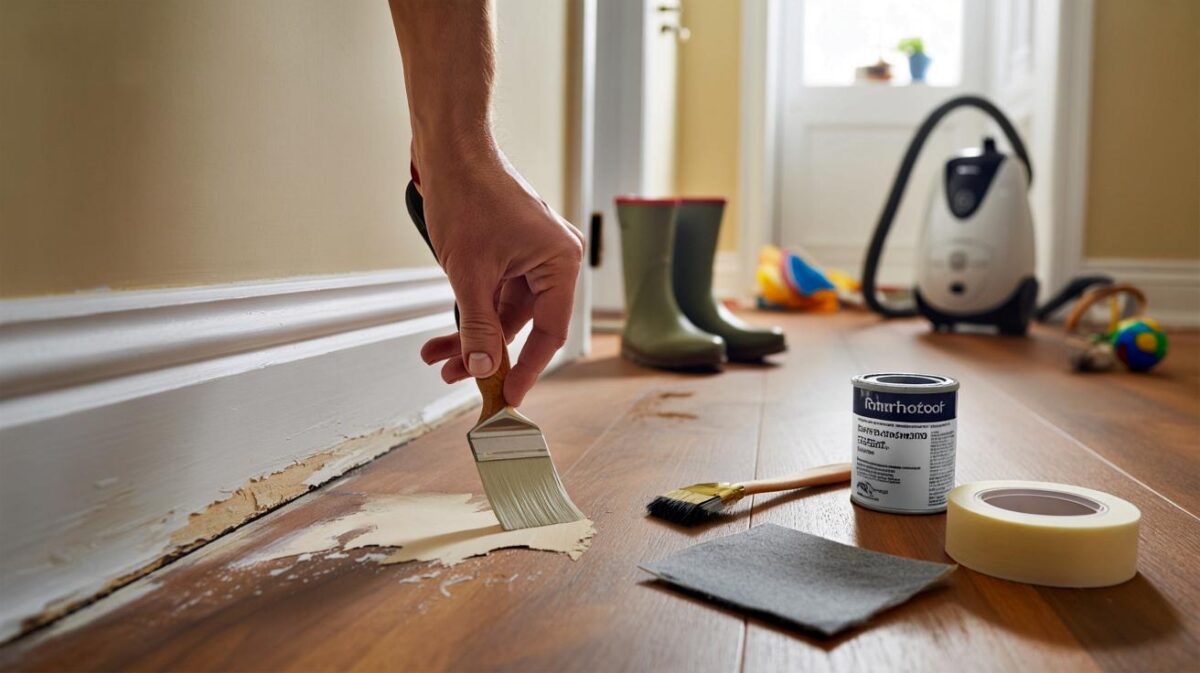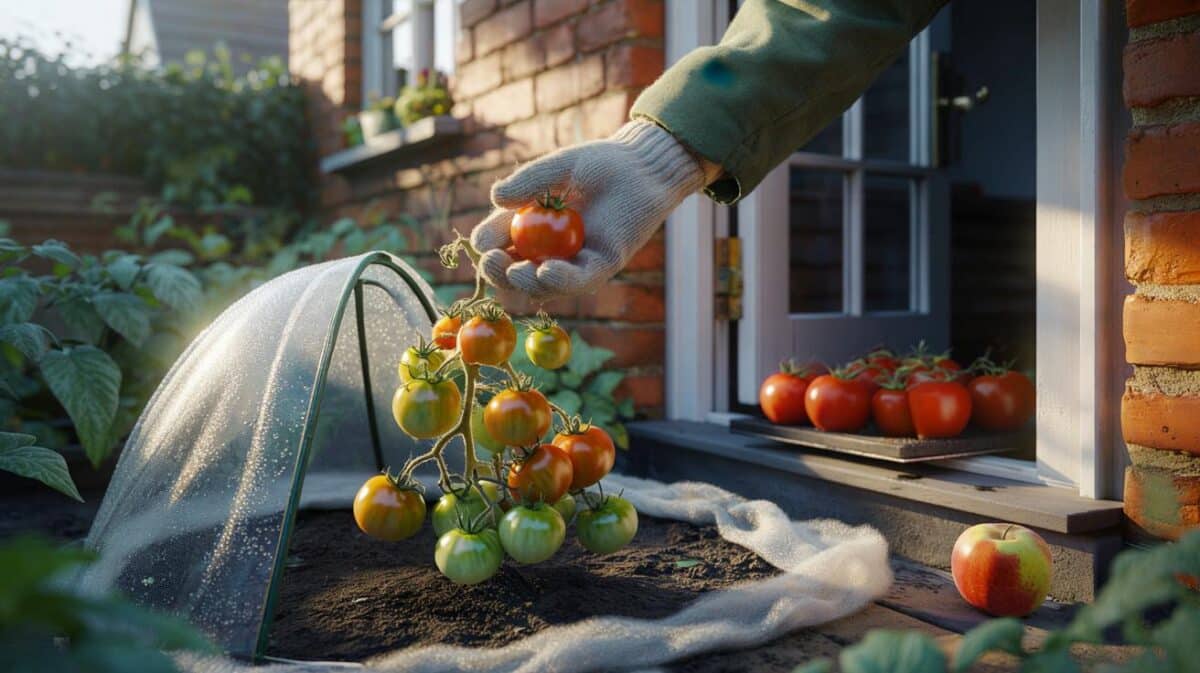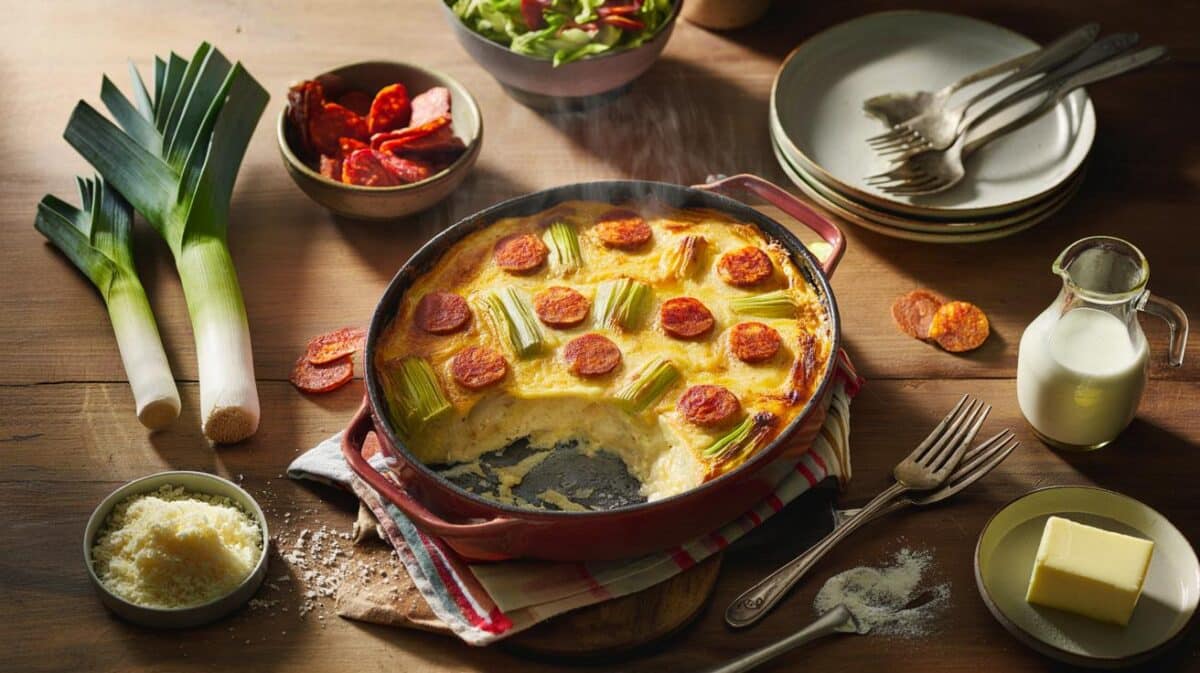Across Britain this late October, the annual rush to rescue green tomatoes has begun. Gardeners bring in trusses, stack them under cover, and try every trick from plastic bags to airing cupboards. Many will wake to the same surprise: nothing happens, or worse, rot. The science of ripening, not folklore, decides the result.
Why your green tomatoes won’t turn red
Ripening is chemistry in motion. Tomatoes produce ethylene, a plant hormone that tells cells to soften, sweeten and change colour. That cascade needs warmth and stable air. When temperatures fall, the signal slows, then stops. If air gets damp, mould moves in before colour does. If fruit gets chilled, its flavour chemistry collapses.
Below 13°C, ethylene production falls off a cliff and ripening often stalls for good.
Many households assume “indoors equals warm”. A chilly conservatory or unheated porch can sit at 8–12°C by dawn in October. That feels sheltered, yet the fruit experiences cold shock. Condensation on smooth tomato skins adds another threat, inviting grey mould to colonise tiny bruises.
The sweet spot looks modest. Aim for 18–22°C, gentle air movement, and no condensation. At those conditions, colour change resumes and flavour develops. Push past the mid‑20s and you rush texture while taste lags. Plunge below the mid‑teens and you wait… and wait… and then give up.
| Temperature | Ethylene response | Likely outcome | Main risk |
|---|---|---|---|
| 0–10°C | Near-zero | No ripening, mealy texture | Chilling injury |
| 11–13°C | Very weak | Stalled colour, dull flavour | Prolonged delay |
| 18–22°C | Steady | Even ripening in days | Mould if air is damp |
| 25–30°C | High | Fast softening, uneven taste | Over‑ripening |
Mistakes that kill ripening
Nights under cover that are still too cold
A polytunnel, verandah or greenhouse feels safe. Yet nights bite. As radiative cooling hits, the air dips. By dawn, fruit can be colder than the outside air because of clear surfaces and trapped moisture. That brief chill is enough to check ripening for days.
If you can see your breath at dawn, your tomatoes felt it first.
The plastic bag trap
Sealing green tomatoes in a plastic bag looks clever: ethylene builds up quickly. But water vapour also builds. Within 24–48 hours, droplets form, pores clog, and mould wins. Soft spots spread from one fruit to the next, hidden until you press the pile.
The fridge effect
Refrigeration stops ethylene’s job. Cold breaks cell membranes that create aroma compounds. Green tomatoes chilled rarely regain taste or texture. Red ones temporarily tolerate short stints; green ones do not. If they go into the fridge before they blush, expect blandness later.
What to do now
Set up a ripening station
Pick fruit that show the slightest yellowing at the stem end or feel just a touch less rigid. Place them in a single layer on newspaper or in shallow wooden crates. Keep fruit from touching to prevent one rotten spot spreading. A ripe apple nearby adds ethylene without overdoing moisture.
Aim for 18–22°C, dry hands, free air, and daylight that is bright but indirect.
Monitor and rotate every day
Turn each tomato a quarter‑turn daily to reduce pressure marks. Wipe any condensation with a clean tea towel. Remove any fruit that smells sour or shows fuzz. Keep a small gap between the crates and the wall to keep air moving.
Spot the moment to bring them inside
Green fruit that feel slightly springy and show a matte cast are ready to finish off the vine. If a cold snap is forecast, harvest in the afternoon after the day’s warmth has lifted internal temperature. Leave very hard, deep‑green fruit to culinary projects instead of forcing them to ripen.
- Ideal room: 19–20°C, relative humidity around 60–70%.
- Best surfaces: newspaper, unvarnished wood, clean cardboard.
- Worst companions: damp tea towels, sealed plastics, sun‑baked sills.
- Target timeline: 5–12 days from first blush at 20°C, longer for beefsteaks.
Signals to trust, not myths
Colour cues and firmness
Look for pale green shifting to yellow‑green, then salmon. Firmness eases from rigid to resilient. Shine dulls before the first blush. Those signs beat any calendar date.
Air, not heat, fixes most delays
Many households turn up the heating. Yet stale, moist air remains the enemy. Crack a window for five minutes twice a day. Space trays by a hand’s width. Dry air slows mould and keeps skin intact long enough for colour to spread.
What if they never ripen?
Don’t bin the stragglers. Green tomatoes carry a bright acidity that sings in the kitchen. Use them deliberately rather than apologetically.
- Quick pickle with cider vinegar, coriander seed and garlic for sandwiches.
- Fried green tomato slices dusted with polenta and smoked paprika.
- Oven roast with honey and balsamic, then serve with blue cheese.
- Savoury chutney with sultanas, onion and mustard seed for winter boards.
- Green salsa with jalapeño, lime and coriander for tacos.
When taste refuses to ripen, technique steps in — acidity becomes your asset.
How this year’s weather shifts the odds
Shorter days mean fewer warm hours to push fruit past the turning point. Clear nights amplify heat loss from glass and plastic. In many post‑harvest allotments, soil warmth fades by late October, so fruit hangers‑on no longer receive heat from below. Timing your final pick matters more than variety at this point.
If your area faces a run of cold nights, move trays to the warmest lived‑in room rather than a utility space. A cheap analogue hygrometer helps. If relative humidity climbs above 75%, run a dehumidifier for an hour or open a window briefly. Balance warmth with dryness.
Practical add‑ons worth trying
Controlled ethylene without the rot
Place one ripe apple or banana beside, not on, a small batch of tomatoes under a loose paper bag or cardboard lid. That traps just enough ethylene while still breathing. Refresh the companion fruit every two days to avoid odours and moisture build‑up.
Prioritise by size and variety
Cherry and salad types colour faster than beefsteaks at equal temperatures. Sort trays: top priority for those showing first pale yellowing; lower priority for hard, dark green fruit which are better diverted to cooking projects. This triage saves time and reduces waste.
A simple risk check for busy weeks
Use a three‑question test before bed: is the room above 18°C? Is the air dry to the touch on the window? Are fruits separated? If any answer is no, make a small adjustment now rather than salvage a mouldy tray tomorrow.
Never refrigerate unripe tomatoes. Once chilled, flavour chemistry and texture rarely recover.
For readers keen to go deeper, a small experiment helps: split a similar batch across three spots in your home — warm lounge, cool hallway, bright kitchen shelf out of direct sun. Note colour change and aroma daily for a week. You will map your microclimates and learn where next autumn’s rescue station should live. That knowledge travels with you, whatever the weather throws at your plot.
Finally, think ahead. Next season, choose a mix of early and mid‑season varieties, prune late flowers in September, and pick at first blush before night temperatures slide. Autumn rewards gardeners who combine curiosity with small, repeatable routines. Your future self — and your sandwiches — will taste the difference.








